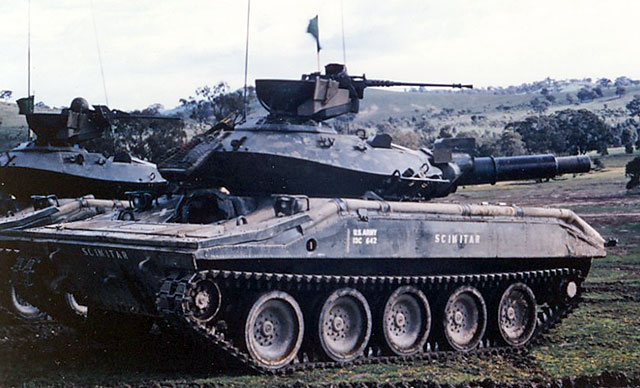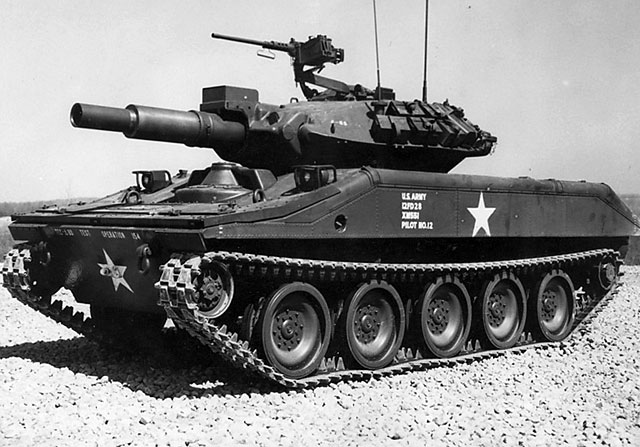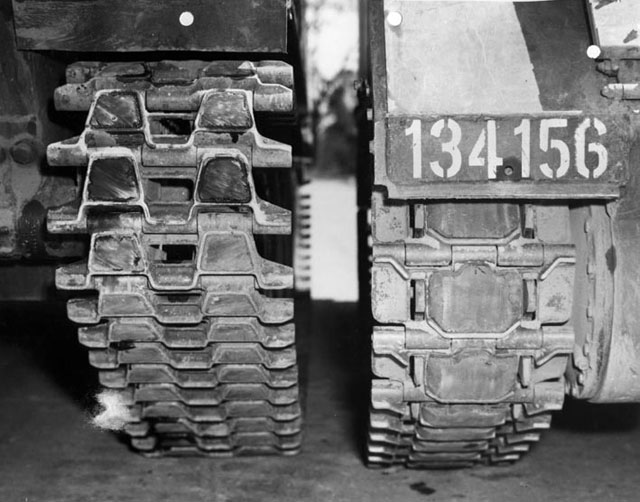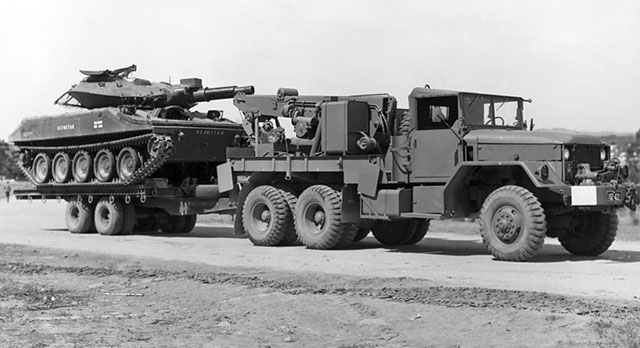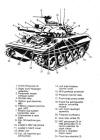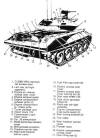|
Sheridan Tropical Trials
|
|
|
|
Sheridan tank "Scimitar" on the range at Puckapunyal. (Photo courtesy Peter Jarratt) |
by Paul D. Handel
![]()
Introduction
In October 1967 I made my first visit to Puckapunyal. Having started about five years earlier collecting information about Australian AFVs, this was my first chance to see the real things.
I was in the company of my uncle who at that time was serving in RAEME and therefore able to get me in to see the Centurions of the Armoured Centre. During one of the tours, I was taken to a workshop building and allowed to look through the gaps between the sliding doors. Not only did I see the prototype of the M113A1 Fire Support Vehicle, but also two US Army Sheridan light tanks, then on trial at Puckapunyal.
This article is about the trials of those tanks in Australia.
![]()
Background to the Trials
In the mid-1960s, a reorganisation of the Australian Army introduced
cavalry regiments into the Royal Australian Armoured Corps. One of the
equipments required for the new cavalry regiment was an air-portable
armoured fighting vehicle (APAFV), and this need was reinforced when
Australia committed an armoured personnel carrier (APC) troop to South
Vietnam in 1965 as part of an infantry battalion group.
Initial attempts by Australia to participate in the development of a
family of light AFVs as part of the ABCA (America, Britain, Canada and
Australia) agreement led to failure, due to conflicting national,
political and commercial interests preventing development of a common
vehicle from proceeding. The Australian Army then became interested in
the newly developed United States M551 General Sheridan Armoured
Reconnaissance/ Airborne Assault Vehicle, and arrangements were made to
obtain two vehicles under an ABCA Standardization Loan for evaluation
purposes.
![]()
Preparation
Several Australian Army personnel were sent to the USA for training on the vehicles, particularly in the gunnery aspects, as the 152 mm Gun-launcher was a completely new system. It was originally hoped to conduct trials during the 1966/67 Wet Season in northern Queensland, but vehicles were not immediately available from the USA. It was not until 28 August 1967 that the two vehicles arrived in Australia. These were new vehicles from the production line.
|
|
|
The XM 551 Sheridan Pilot model No.12 shown in this official US Photograph. |
After landing in Melbourne, the two vehicles were initially taken to the
Army Design Establishment (ADE) in Melbourne for checking and fitting of
instrumentation for trials purposes. Crew training was conducted at the
Armoured Centre at Puckapunyal, and some firing trials of the secondary
armaments took place. For ease of identification during the trials, the
vehicles were named SCIMITAR (US Registered No 13C642) and SABRE (US
Registered No 13 C 643). As a comparator vehicle during the automotive
testing phase, an Australian M113A1 vehicle was used.
![]()
Tropical Trials
Beginning in January 1968, the main phases of the trials took place. The vehicles had been moved to the Innisfail area of Northern Queensland in December 1967, and were prepared by the specially formed Sheridan Trials Unit for the various trials to be undertaken.
The trials conducted were those which had not already been conducted
by US authorities. The environment around Innisfail includes jungle,
swamps, beaches and grassy, lightly timbered areas, ideal for the
conduct of tropical trials. This area was the location for the
Australian Army’s Tropical Trials Establishment, and was the scene of
trials in 1962/3 of the US M113 and UK FV432 Armoured Personnel
Carriers, and later in 1972/3 of the Leopard and M60A1 tank trials.
Automotive trials included all types of performance and swimming trials,
and a long distance endurance trial of some 300 miles. One vehicle
completed in excess of 4000 miles during trials, the second vehicle just
over 3000 miles. It was found that the Sheridan was an easy vehicle to
drive and maintain. In the main, its automotive performance was found to
be not as good as the M113A1, although its step and trench ability (due
to its longer length) was better. This inferior performance,
particularly in jungle conditions, was judged to be due to the vehicle
having less aggressive track link design than the M113A1, and a slightly
lower power-to-weight ratio which accounted for some of the lessened
performance, particularly on first and second class roads.
|
|
|
Comparison of the track types of the Sheridan, left, and the M113A1, right. |
Its swimming ability, using the inbuilt flotation screen, was
slightly superior to that of the M113A1. It should be noted that the
M113A1 has never been a star performer in the water, so the statement is
relative. The Sheridan was a more stable vehicle during amphibious
operation, but required the vehicle commander to guide the driver as the
clear panels in the bow plane were usually under water or so damaged the
driver could not see safely.
During the wettest part of the trials, in March 1968, a series of “
battlefield days“ were conducted, which required the crew to operate the
vehicle for 24 hours under simulated combat conditions. It is believed
that these activities proved the vehicle to be relatively satisfactory
in automotive terms.
|
|
|
Scimitar with its flotation screen erected crossing a river during swimming trials. As well as the crew commander and gunner standing to provide guidance to the driver, a number of additional trials personnel have hitched a ride on the vehicle. |
Engine cooling was the major automotive problem. This was caused, in
jungle conditions, by the tracks throwing debris causing blockage of the
engine radiator. A local solution, using a wire mesh screen, was applied
for the duration of the trials to each vehicle.
The gunnery aspects of the Sheridan were another matter. The M81 152 mm
Gun/ Launcher, capable of firing missiles as well as conventional
ammunition, was not a success. Both conventional ammunition and missiles
were fired during trials, the most serious defect being in the
combustible case of the conventional round. Although the case was
supposed to be completely combustible, the breech scavenging system did
not completely remove debris, which often fell into the turret upon
breech opening. Personnel involved in the trials indicated that this was
a major problem. Because of the possibility of these hot debris falling
into the turret where large calibre rounds with combustible cases were
stored, only one live round at a time was allowed in the vehicle. In
addition the obscuration produced when such a large calibre round was
fired, and the lack of a range finder, limited the effective range to
somewhere around 600 metres.
![]()
Trials Aftermath
The tropical trials were completed in June 1968, and the vehicles
were returned to the Army Design Establishment in Victoria, where
additional trials were conducted. Several demonstrations and firings
took place on the AFV ranges at Puckapunyal over the next months, and
final examinations of the vehicles were undertaken.
Sometime in early 1969, the vehicles were returned to the US workshops
in Japan for rebuild. Quite why the vehicles went there and not to the
USA is uncertain, but by that time Sheridans were deployed to South
Vietnam and perhaps these trial vehicles were rebuilt and sent to that
theatre.
|
|
|
The Sheridan named Scimitar being carried on board an Australian Army 15 ton Tilt Bed Recovery trailer, and being towed by an M543 Wrecker. The Sheridan overhangs the deck of the trailer about half a track width on each side, making transport by that means very problematical. |
A government statement, issued by the Minister for the Army in January
of 1969, said that the Sheridan would not be introduced into service
with the Australian Army, as it did not meet Australian Army
requirements. Although no technical reasons were given in the statement,
it is believed that the deficiency of the 152 mm gun and ammunition
system was the main factor in the decision not to adopt the Sheridan.
The decision not to adopt the Sheridan accelerated another project which
did come to fruition, the mating of a Saladin Armoured Car turret to an
M113A1 Armoured Personnel Carrier to produce an M113A1 Fire Support
Vehicle.
The Tropical Trials of the Sheridan were the most complex and exhaustive
military vehicle trials conducted in Australia up to that time, and were
important in developing the system for trials of military equipment,
particularly armoured vehicles, to assess their suitability for the
Australian Army.
![]()
Acknowledgements
Little in the way of unclassified Australian documentation is presently
available, and much of the information contained in this article is a
result of snippets of information gleaned from personnel associated with
the trials, or from brochures and contemporary news articles. Some of
the photos are from the collection of the RAAC Memorial and Army Tank
Museum, others from private individuals.
![]()
Sheriden Tropical Trials in Australia Photo Album
Click
the thumbnails in the table below to view the images full size.
Use your browser's "back" arrow to return to this page.
![]()
Article Text Copyright ©
2005 by Paul D.
Handel
Page Created 25 April, 2005
Last Updated 25 April, 2005
Back to Anzac Steel Main Page
